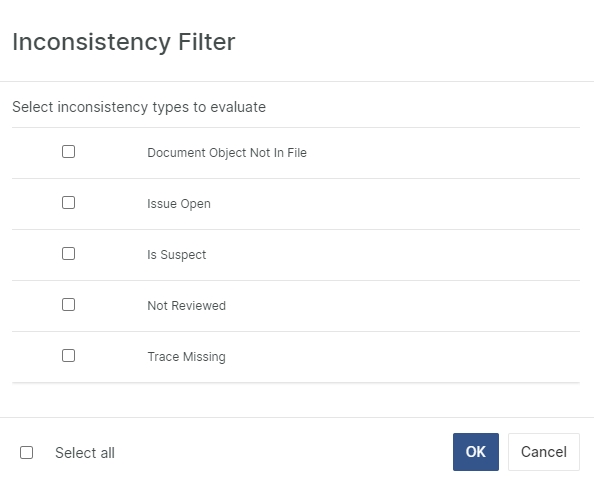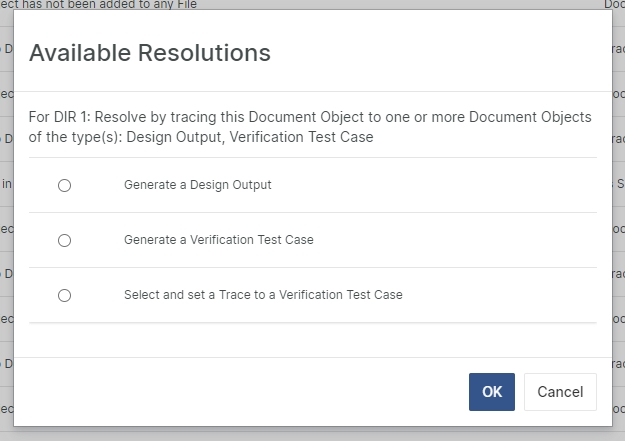Display Inconsistencies
Inconsistencies
Inconsistencies are in Aligned Element gaps, incompatibilities, or contradictions in your project according to a set of defined but customizable rules called Validation rules.
A large number of validation rules are available to analyze the different document object types, such as:
Trace missing (e.g., a requirement should at least have a trace to one Specification)
Incoming Trace missing (e.g. a Specification should at least have a trace from a Req)
Risk is not mitigated (i.e., too high NRPN (risk) after mitigation (or mitigation missing))
Severity is not mitigated (i.e., too high severity after mitigations)
A document object has not been reviewed (or only in a previous revision)
A document object has an open issue
A document object contains an attribute whose value is not as predefined; e.g., an executed test case has the Result = Failed
A Test case has not been executed in its current revision
A trace is set as suspect if the parent document object tracing to another object is changed after the trace to the child object is created.
Document Object is not included in any file document object
A file document object contains document objects that are not up-to-date
The document object has a date attribute whose value is overdue
A document object has a signature that is not closed
Illegal traces; i.e., an object has a trace to an object of a type that is formally not making sense
Obsolete linked traces; i.e., an object has a trace to a linked object of a non-most-current revision
A Document Object is missing a Signature
Has Consistent Classification, can be applied to Software Items with a classification attribute (i.e., A, B , C) and checks if the severity of a Harm traced via Risk Analysis and Cause match the current classification. Tracing to a No Cause is a way to justify Safety Classification ‘A’
A DHF Line Item defines a deliverable that is not fulfilled
A DHF Line Item has a current status that does not match the “Status per Phase” definition set up for the document
If a validation rule criteria are not met, an inconsistency is displayed.
How to display the Inconsistency View
To display Inconsistencies of all objects of a given Document Object type (or all objects of all types), select the corresponding Type Name in the Inconsistency-drop down under Project Status in the Navigation Bar.
In the subsequent Inconsistency Filter dialogue, select the Inconsistency Types to evaluate. The dialogue only presents inconsistency types that are available for the particular type.

After selecting the applicable Inconsistency Types and clicking OK, the Inconsistency view displays the Document Objects with their corresponding inconsistencies.

Use the Action button to:
Generate Multiple...
Display Consistency Coverage
Display Chart
Set Snapshot
Generate a Word Report
Generate a Template-based Word Report
Generate Excel Report
Create File for Objects
Export the Document Objects
Set Un-suspect
Create Issue
Resolve Inconsistencies
Refresh Inconsistencies
Resolve Inconsistencies
Aligned Elements does not only display currently outstanding inconsistencies. It also provides the user with direct actions to solve them. Click on the Take Action button next to an inconsistency to get informed about available resolutions.

The resolution mechanism provides available options based on the current user's permissions, the item's state and the project context. Select the option that is the most appropriate to resolve the inconsistency.
Some inconsistencies, such as Not Reviewed, Suspect Trace and Not In File, can be resolved in batch mode. Use the Action menu item Resolve Inconsistencies to select and resolve inconsistencies in batch mode.
Refresh after Resolve
After resolving inconsistencies, click Refresh Inconsistencies in the Action dropdown to view the updated inconsistency state.
Create Issue, based on an Inconsistency
Use the Action button to Create an Issue based on the selected inconsistency. The inconsistency information will be automatically added to the Issue, which in turn will automatically be traced from the selected item.
